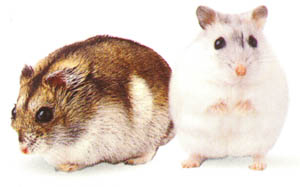

Professor
Department of Biology
Western University
1151 Richmond St. N
London, Ontario, Canada
N6A 5B7
Office: Biological & Geological Sciences 3020
Email: jfstaple@uwo.ca
Phone: 519-661-2111 x 84057
Fax: 519 661-3935
Although I’m not currently working on these projects, I have in the past and hope to in the near future.

In summer hamsters are active and have brown/gray fur.
As winter approaches the fur turns white and they enter daily torpor (photo by T. Bartness)
Metabolism in Daily Torpor: Other small mammals, such as this dwarf Siberian hamster (Phodopus sungorus), go through daily torpor in the winter, whereas mice enter torpor when deprived of food. Although superficially resembling hibernation, daily torpor lasts for only a few hours, and reduces body temperature and metabolic rate by relatively modest amounts. By comparing mitochondrial properties between hibernation and daily torpor we hope to better understand the mechanism of metabolic suppression.
Comparative Biochemistry of Aging: Aging and senescence are thought to be caused by the accumulation of damage by Reactive Oxygen Species (ROS, also called “free radicals”) which are produced by mitochondria. Mice, big brown bats and house sparrows have similar body masses and metabolic rates, but radically different maximum life spans - while mice live just 2-3 years, bats and sparrows can live up to 20 years. By comparing mitochondrial ROS production among these species we hope to understand what accounts for the apparent difference in rates of aging among these species.
Insect Muscle Metabolism: During flight insects such as this Bumblebee (Bombus spp.) produce some of the highest mass specific metabolic rates among animals. Our research indicates that during routine flight, many oxidative and glycolytic enzymes work close to their maximal capacities. In contrast, maximal exercise in most vertebrates rarely employs more than 20% of enzyme capacity. It appears that the metabolic components of these high-performance insects are pushed close to the design constraints of the system as a whole. We also research enzymes systems in bumblebees that may help them produce heat in cold climates.
Hypoxia Tolerance in Chambered Nautilus: The chambered Nautilus (Nautilus pompilius) lives on steep fore-reef slopes of coral islands in the southern Pacific and eastern Indian oceans. Although they may come as shallow as 75m at night, they retreat to the depths (up to 600m) during the day. Oxygen content may be low at these depths. In addition when threatened Nautilus retreat into their shells and cannot ventilate their gills. Therefore it is not surprising that these cephalopod molluscs can tolerate several hours of severe hypoxia. Research with Dr. Bob Boutilier suggests that this hypoxia tolerance is largely due to a reduced metabolic rate as ambient oxygen falls. Nautilus may also be able to use its shell as a SCUBA tank, exploiting the large oxygen stores contained in its chambers.